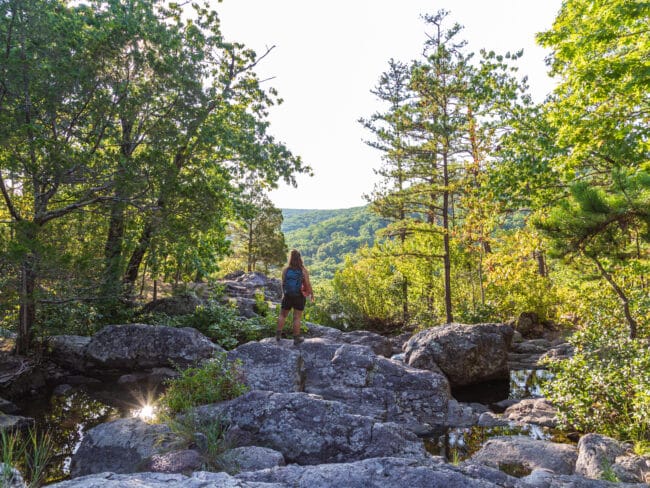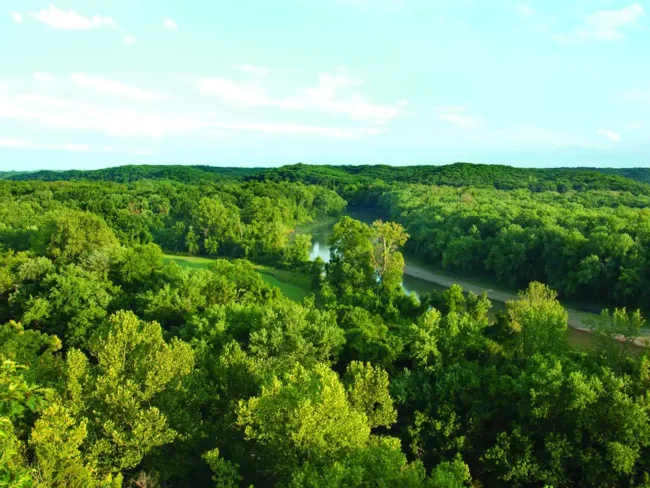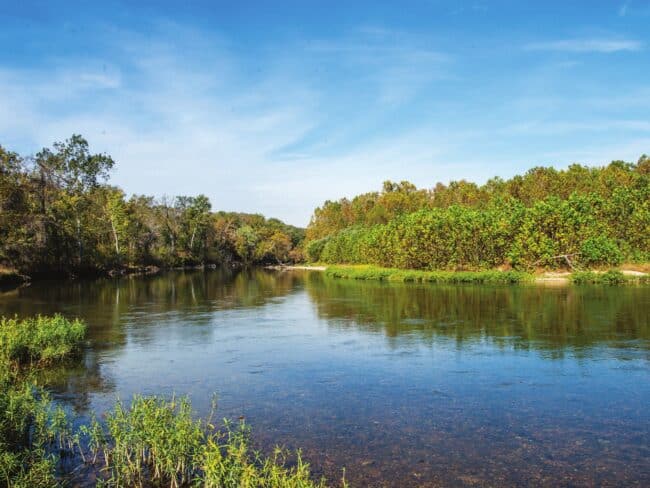Going outside in any weather is good for mental health. Bundle up and get outdoors at one of these 5 great state parks selected for their extra-rewarding winter experiences. What a great way to burn off those extra holiday calories!
Shake off the ‘brrrr!’ and warm up to the outdoors.
Missouri’s ninety-two state parks and historic sites provide opportunities for outdoor recreation year-round, from camping and hiking to bicycling and horseback riding. But some of Missouri’s parks offer unique experiences best enjoyed in cold weather. The bugs (and crowds) are gone, the vegetation has gone dormant, and maybe, just maybe, there’s snow on the ground. Here are five cool Missouri state parks for winter exploration. If you want to explore all of Missouri’s state parks, you might like our handy guide.
Big Lake State Park
Northwest, of St. Joseph, Mo., Big Lake State Park is only about four hundred acres in size, but it packs an incredible amount of wildlife diversity into that space. The park is located along the 646-acre Big Lake, the largest oxbow lake in the state that formed when the nearby Missouri River shifted its course. An adjacent wetland covering nearly three hundred acres provides a habitat for an impressive array of birds.
Nearly 230 species of birds have been identified in the park. Combined with the nearby Loess Bluffs National Wildlife Refuge, the area is a stop for migratory birds on the Mississippi and Central flyways. Snow geese are common in the winter months, along with species like Ross’s goose, the greater white-fronted goose, and the cackling goose. Several duck species can be seen in winter here, too, like northern shovelers, gadwalls, mallards, green-winged teal, bufflehead, common goldeneye, and common merganser.
Then, there’s the American coot, white pelicans, and three species of gulls. Bald eagles are especially prevalent in the winter months and can be spotted hunting for food in the lake. They number in the hundreds, with nearly five hundred counted in a 2001 survey. Red-tailed hawks and northern harriers can also be spotted this time of year.
“Its location on the Missouri River draws a wide variety of waterfowl in winter,” Edge says, “and its location near St. Joseph contributes to its popularity among birders.”
Loess Bluffs National Wildlife Refuge spans more than 7,400 acres and is located just east of the state park. The ancient bluffs were formed by silt deposited by glaciers and covered nearly 700 acres, with the rest of the area covered by wetlands, grasslands, and forests. The National Audubon Society has named the refuge one of the top 500 Globally Important Bird Areas in the United States.
Visitors can take it all in on the ten-mile Wild Goose Interpretive Auto Tour Loop and the two-and-a-half-mile Mallard Marsh Auto Tour. There are also four hiking trails. Find out more about Big Lake State Park.
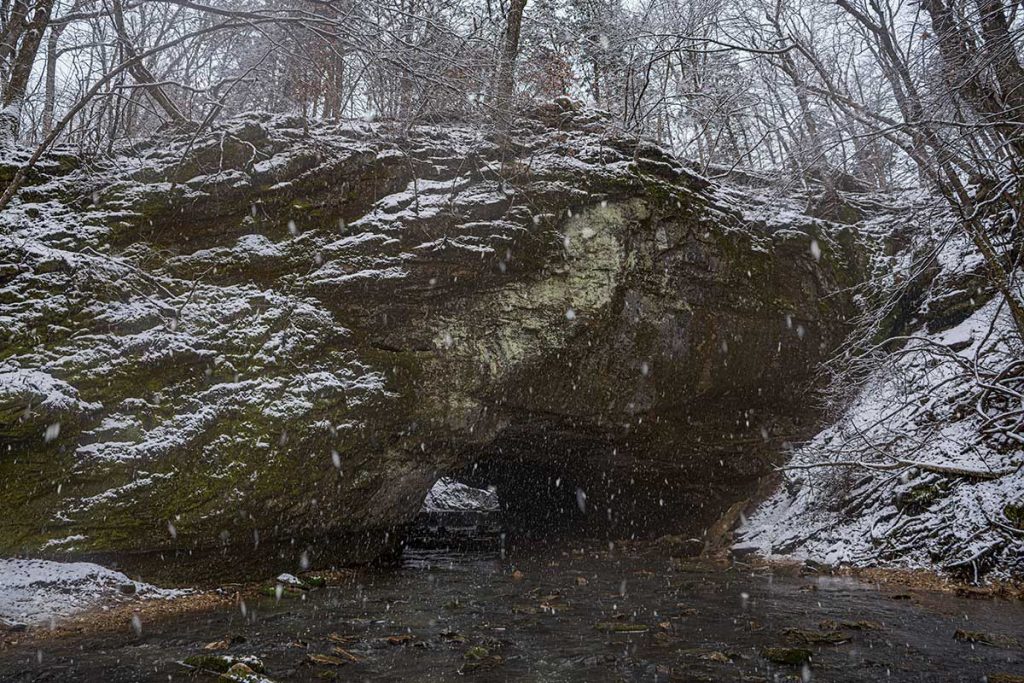
Notley Hawkins photo
Rock Bridge Memorial State Park
South of Columbia, Mo., Rock Bridge Memorial State Park was established in 1967 in memory of Carol Stoerker, the nine-year-old daughter of a University of Missouri professor who died after she was struck by a car. It’s a tranquil place featuring karst topography with caves, sinkholes, and springs, and one that has been frequented by locals for roughly two hundred years.
The stream that flows from Devil’s Icebox Cave was the site of the first paper mill west of the Mississippi River, and there was later a whiskey distillery there. The park’s namesake rock bridge was created when part of the cave system collapsed. Today there are eight trails in the park, and at least two are well-suited for cross-country skiing in the winter months.
The Grassland Trail is 1.9 miles long and rated moderate for hikers. In the warmer months, it is home to a variety of grasses and wildflowers. The moderate High Ridge Trail is 1.7 miles in length and, as the name suggests, provides scenic views from one of the highest points in the park before descending into a wooded area along a small creek. While cross-country skiers can use other trails, these two have less exposed rocks that can damage skis when there isn’t much snow. Visitors can ski on these trails after only a few inches of snowfall.
Park manager Sarah Jones has worked at Rock Bridge for five years and says last winter provided some snow deep enough for people to cross-country ski at the park. She recommends at least six to eight inches, and her trail picks are the Grassland Trail and the 1.9-mile Karst Trail that winds through woods and grassland areas.
“They’re wider, they’re not as rocky,” Sarah says. “It would be easier to get around because some of our trails will have a lot of switchbacks and almost even stairs on them.”
The longest trail in the area winds more than six miles through the adjoining Gans Creek Wild Area and is also open to equestrian riders during part of the year. Inside the park, there are options for hiking and mountain biking, including the Deer Run and Spring Brook trails, each at least three miles long. There’s also a half-mile boardwalk to the Devil’s Icebox Cave, with its six-and-a-half-mile passage that’s home to endangered gray bats and a species of flatworm, the pink planarian, found nowhere else on Earth. Even if you don’t own a pair of skis, Sarah says, Rock Bridge is a popular park when it snows. Learn more about Rock Bridge Memorial State Park.
“A lot of people come out here when it snows because it’s a great place to walk through the woods,” she says. “It’s just gorgeous.”

Photo courtesy Missouri Department of Natural Resources
St. Joe State Park
Not long ago, the area south of Park Hills, Mo., would have been an inhospitable place for recreation. Located right in the middle of Missouri’s lead belt, it was here the St. Joseph Lead Company operated for more than one hundred years—helping produce most of the lead mined in the United States for decades. All that mining activity left a legacy in the form of tailings, a fine gravel or sand-like material created from crushing limestone rock hauled from underground to extract the valuable ore.
The resulting moonscape just so happens to be an ideal setting for off-road vehicles. And, when there’s enough snow on the ground, it’s a perfect place for snowmobiles. The land, which was donated to the state in the 1970s after the St. Joe Minerals Corporation stopped mining there, now features an extensive trail system that crisscrosses through the heart of the park. Fifty-four miles of trails are open to off-road vehicles (ORV), and riders can experience the sand-flats area as well as surrounding wooded hillsides.
How much snow does it take to break out the snowmobile? Opinions vary, but at least four to six inches should be enough to get out and do some riding. Matt Tarkington, who works at Big St. Charles Motorsports, has ridden snowmobiles at St. Joe. He recommends at least a foot of snow if you want to ride the trails, which have some big rocks. The sandflats are a better option.
“You can ride in three or four inches and still get the sled to cool properly but the more snow you’ve got the better they handle and turn,” he says. “Usually out in the flatlands you can get going pretty well.”
St. Joe is one of two state parks in Missouri with dedicated ORV areas, along with Finger Lakes State Park near Columbia, which is also located on mined land. At St. Joe, there’s even a campground near the riding area with both electric and basic sites, and trails leading to the ORV section, so visitors can park the snowmobile next to their tent or camper.
The park also features four lakes and a handful of trails open to other pursuits. The Monsanto Lake Water Trail is a mile and a quarter long and ideal for kayaks or canoes. There’s an eleven-mile paved bicycle trail that can be used for cross-country skiing if the weather cooperates, and the Pine Ridge Trail is more than twelve miles long and used for hiking, mountain biking, and horseback riding. It includes five trailside camping sites for backpackers wanting to get away from the bustle.
While you’re waiting for the snow to fall, visit Missouri Mines State Historic Site and tour the mining museum featuring mineral specimens and antique mining equipment. There’s a path connected to the bicycle trail that leads visitors right to it. The historic site occupies the twenty-five-acre area where the St. Joseph Lead Company once operated a mill and includes a nineteen-thousand-square-foot powerhouse. Discover more about St. Joe State Park.
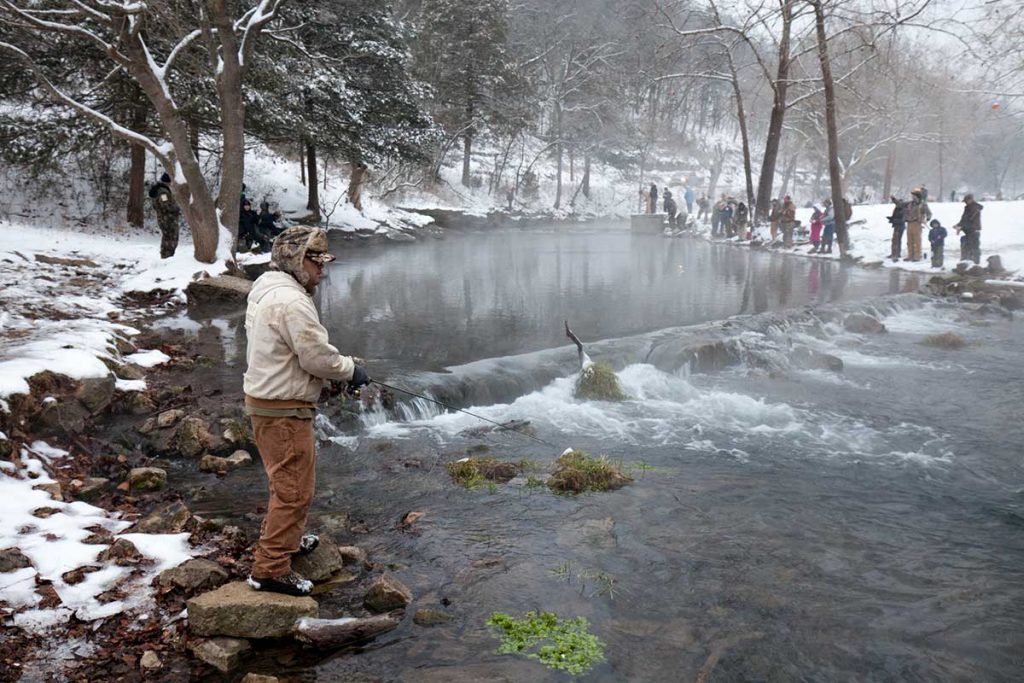
Photo courtesy Missouri Department of Natural Resources
Roaring River State Park
Nestled in a deep valley in the Ozarks south of Cassville, Mo., Roaring River State Park is one of three parks in Missouri stocked with rainbow trout. While visitors can try their hand at fishing year-round, the winter months are limited to catch-and-release, and the crowds that occupy the banks in spring and summer are nowhere to be seen.
Tim Homesley, who operates Tim’s Fly Shop outside the park, is an authority on fishing there and says he lives for winter fishing. Tim’s reasons are simple: fewer people, more fish, and bigger fish. The hatchery usually puts out some better fish in the winter, and the river itself doesn’t change much because it’s spring-fed.
“It’s the same temperature in July as it is in January,” Tim says. He fishes with small dry flies and midges in the winter. Roaring River is a tributary of the White River and originates at Roaring River Spring, which produces more than twenty million gallons of water every day and is the deepest in the state. It’s that cold, clear water that makes Roaring River the perfect stream for trout, and the park is a perfect location for a trout hatchery managed by the Missouri Department of Conservation.
The catch-and-release season runs from the second Friday in November through the second Monday in February from 8 a.m. to 4 p.m. and is limited to Fridays through Mondays.
“You might, on a really busy day, have three or four hundred people fishing,” he says. “But if the weather’s nasty, sometimes there’s only fifteen or twenty of us on the river. I have fished when the weather’s really bad, and there’s just three or four of us.”
While there are normally three zones of the stream allowing different types of lures and natural baits, during the catch-and-release season only flies can be used, which makes winter a perfect time to try your hand at fly-fishing. There’s no need for a daily trout tag during the catch-and-release season, just an annual trout permit that can be purchased at the park office.
If the fish aren’t biting, the park features seven hiking trails. The shortest, but steepest, is Deer Leap Trail which climbs high above the hatchery and spring. The 2.6-mile Eagles Nest Trail follows a ridge to one of the park’s highest points, and the 4.4-mile Fire Tower Trail takes hikers into the area’s vast wilderness.
No matter what the winter season brings, adventure can be found in Missouri’s state parks. Whether you’re waiting for the first good snowfall or are interested in seeing migration on a huge scale, this list can point you in the right direction. And if the weather’s especially lousy, you’ll still find Tim Homesley on the riverbank with a fly rod in hand. Here’s more information about Roaring River State Park.
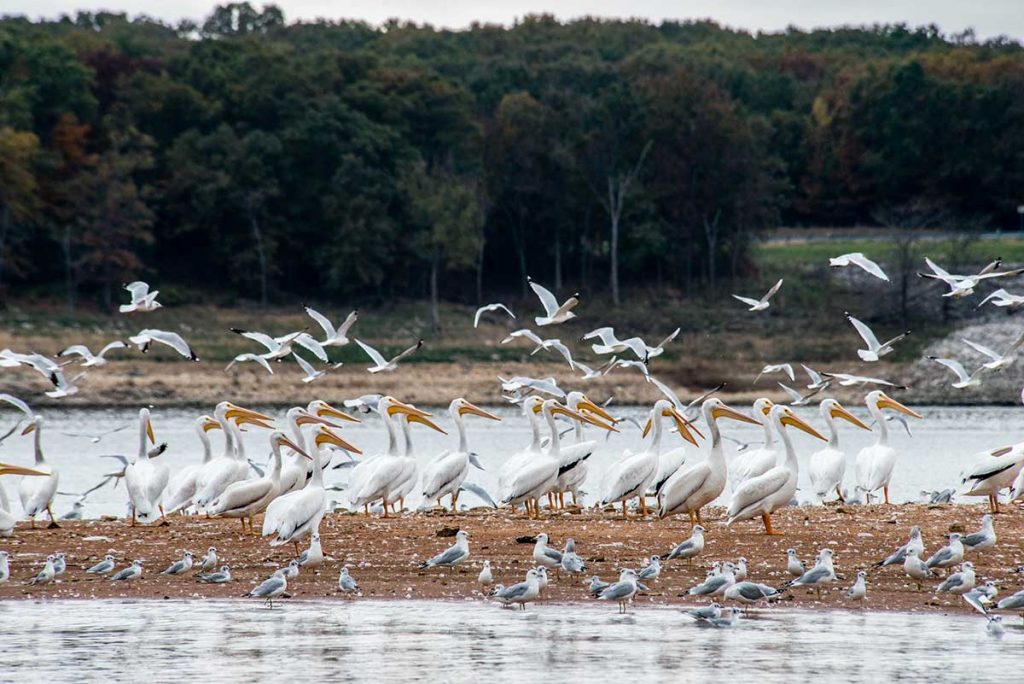
Photo courtesy Missouri Department of Natural Resources
Mark Twain State Park
Mark Twain State Park, named in honor of the famous author who was born nearby, looks quite different today than when it was established nearly one hundred years ago. Originally overlooking the Salt River, the park now overlooks the eighteen-thousand-acre Mark Twain Lake that was created in the 1980s when the river was dammed.
Located southwest of Hannibal, Mo., the park is listed on the Great Missouri Birding Trail with the lake attracting various migratory waterfowl like blue-winged teal and ruddy ducks. At least 150 species of birds have been recorded in the park as part of an agreement between the Missouri Birding Society and Missouri State Parks where birders document what they see, and the society maintains a checklist. Many of those species spend their winters here. Among the most popular winter visitors are bald eagles, which have even begun nesting in the park. White pelicans pass through in fall and spring.
Edge Wade, the Missouri Birding Society vice president, says the list of 163 species documented there is likely a misrepresentation of the area’s potential. There are relatively few reports from there in the winter months when waterfowl are present.
“Birders have much exploring to do here in winter,” Edge says. Visitors in winter have a chance to view at least five different species of woodpeckers in addition to ruby-crowned kinglets, yellow-rumped warblers, white-throated sparrows, and dark-eyed juncos. Red-shouldered, red-tailed, and rough-legged hawks can be spotted, too, as well as American kestrels and merlins from the falcon family.
There are five trails in the park for bird watchers to use. The longest is the 2.3-mile Dogwood Trail through an oak-hickory woodland. The White Oak Trail covers 1.3 miles while looping inside a peninsula on the lake. The park also includes the Mark Twain Birthplace State Historic Site which features the cabin in which Twain was born in the village of Florida. There’s also a museum and research library.
There are three campgrounds at the state park available year-round to pitch your tent, along with six camper cabins inside the Puma Campground. Find out more about Mark Twain State Park.
Article originally published in the Janurary/February 2022 issue of Missouri Life
Related Posts
Castlewood State Park
Castlewood State Park has more than thirty miles of hiking and biking trails, eleven of which are open to horseback riders. Experience the feel of a mature floodplain forest with its silver maple, box elder, black willow, white ash, sycamore, slippery elm, and hackberry. Bring a picnic and enjoy the beauty of this park.
Start Your Journey to Our State Parks
You have to make this trip! Immerse yourself in native woodlands and forest, streams and springs, and uplands and pastures. Cool off in a crystal clear river. And how can you miss the house that the Beatles visited while in Missouri.

